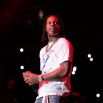You know a hipster when you see one. The fashion, the fixed-gear, the bizarre fascination with out-of-date music formats (guilty!). Hipster music is less easy to define. Sure, there are obscure alt-bands, but Brooklynites also heavily endorse hip-hop heavyweights like Jay Z and Norwegian black metal bands. Describing music as "hipster" is generally misleading. Fortunately, our friends at Priceonomics Data Services have created a formula for determining an act's hipster score.
The first indicator is a positive review from Pitchfork. The site took every 2013 act that received a "best new music" rating from the magazine. That classification means a score between 8 and 10. Then, they check out how many Facebook shares the review got. They theorize a more popular act gets more shares. When the data is charted, Priceonomics charted a linear regression to predict how many shares an album of rating x "should" get. Performers that chart above the line are unhip, and those below are hip. A final score is taken by subtracting the actual number of Facebook shares from the theoretical number, and measuring the percent difference. We wish we could lay this out as a formula, but we don't know how they calculated the linear regression. Sorry.
The point is that some performers were found to be amazingly hip, such as electronic musician The Field, whose album Cupid's Head received an 8.7 from Pitchfork while receiving only 500 Facebook shares, a 403 percent difference than Priceonomics predicted. The results also demonstrated that some bands, no matter how much Pitchfork loves them, are simply too popular to be hip. Case and point The National, who received a 8.4 score for Trouble Will Find Me and a disproportionately high 6,600 Facebook shares.
You can check out Priceonomics' chart above, and check out the full lists of "most-hip" and "least-hip" here.
© 2026 MusicTimes.com All rights reserved. Do not reproduce without permission.

![Tekashi 6ix9ine Targets Lil Durk's GF India Royale Online After Second Home Invasion [FULL STORY]](https://d.musictimes.com/en/full/95883/tekashi-6ix9ine-targets-lil-durks-gf-india-royale-online-after-second-home-invasion-full-story.jpg?w=103&h=103&f=21f3122f04fea6482ca51991c3c6c969)


